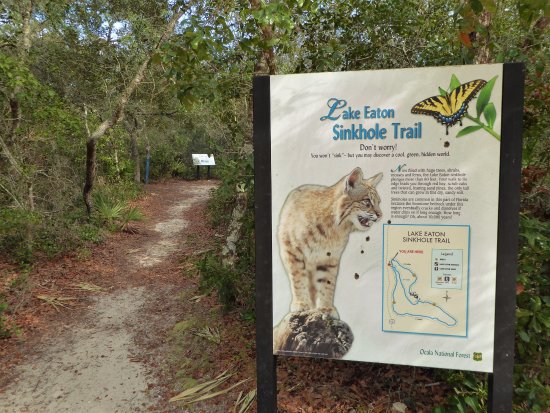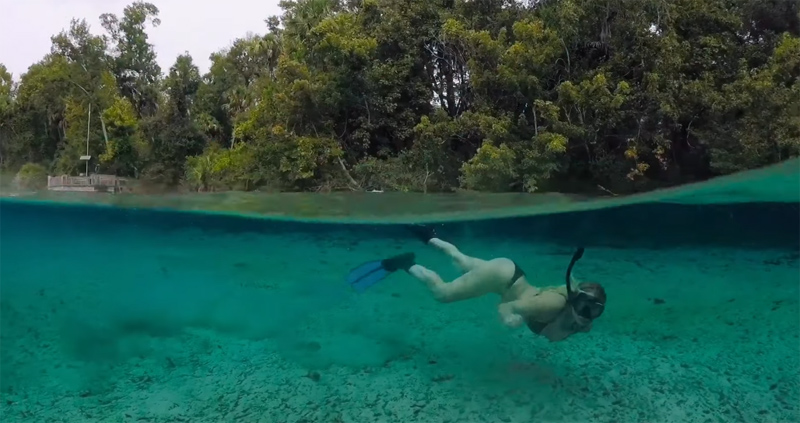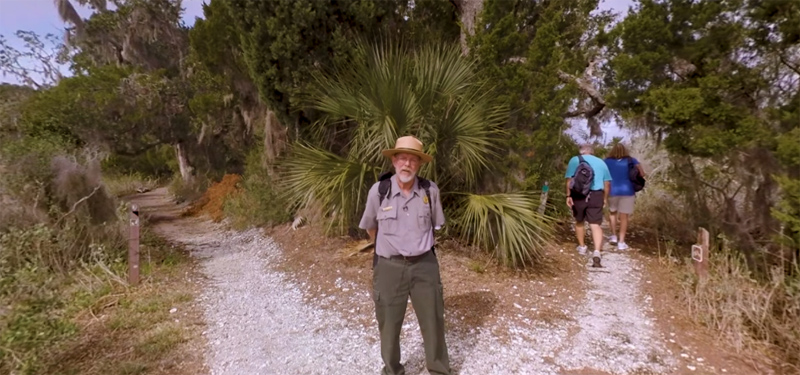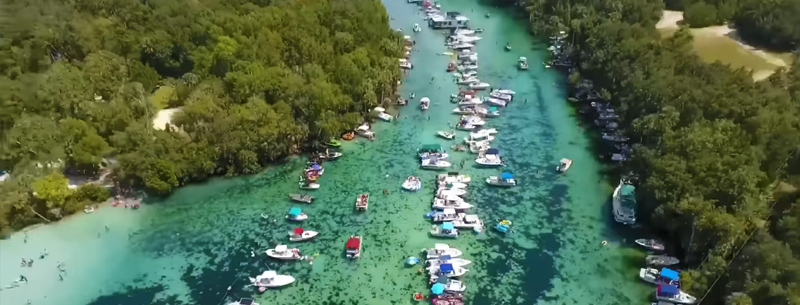The Ocala National National Forest in Florida is an amazing place to explore. With more than 383,000 acres consisting of wilderness and water resources, including rivers, lakes, and springs, there are more than enough activities to enjoy. On our road trip to the forest this past weekend, we had fun hiking, kayaking, snorkeling, and swimming. Our first stop was an off-the-beaten path hike to Lake Eaton Sinkhole Trail.
Located in the northern part of the state in the “rolling” hills of Florida lies the city of Ocala also known as Tree City, USA.
If you’ve never visited the northern region of the state you’re definitely in for a big surprise. While Key West, located at the southern tip of the state has a very tropical atmosphere of balmy breezes, sandy beaches, and deep-sea fishing boats, the northern part of the state boasts cooler weather, rolling green hills, and thoroughbred horse farms.
There’s also this huge area called the Ocala National Forest that consists of 383,573 acres! Camping is very popular in the Ocala National Forest and both full-service campgrounds and rustic camping sites are available. There are numerous hiking/walking trails as well as horseback riding trails. Located within the forest is Alexander Springs with cool crystal clear water perfect for snorkeling and Silver Glen Springs has a spring basin filled to the brim with Striped Bass that likes to get up close and personal. Also found within the forest is the Juniper Prairie Wilderness nature reserve which encompasses 14,000 acres within the forest and has many interesting ecological areas for you to observe. Be sure to bring your camera as you never know what interesting specimen you might discover.
Salt Springs Run Marina & Landing
Salt Springs Run Marina and Landing is also located within the forest and offers a variety of activities such as fishing, snorkeling, or swimming in Salt Springs. Whether you bring your own boat or want to rent a canoe, power skiff, or pontoon boat, you’ll be able to meander down the Lake George or St. John’s rivers. Tackle, bait, bug repellent, and fishing licenses are available at the marina.
There are plenty of fish to be caught, such as striped bass, catfish, and largemouth bass, and if bird watching is a pastime, keep your eyes peeled for great blue herons, osprey, egrets, and bald eagles. Don’t be surprised if you see alligators lazing away in the afternoon, so be sure and keep your hands in the boat!
Whether you’re a certified ecologist, environmentalist, teacher, or just someone who appreciates and respects the great outdoors and the residents inhabiting this natural environment, the forest offers a close-up look at the habitat, flora, and fauna that are native to the region.
Rainbow Springs State Park
Another area you might like to visit is Rainbow Springs State Park which offers 600 acres of natural parkland to explore, including two waterfalls, and another 400 acres of campgrounds. Be sure to take advantage of the swimming and snorkeling available in the cool, clear waters of the spring. It’s very invigorating! Check out this link to Rainbow Springs for information on snorkeling.
Silver Springs
If water sports is your choice of entertainment, then the place to visit is Silver Springs, one of the premier tourist attractions in Florida. The park was established over a century ago when visitors came to the artesian springs by stagecoach and is now celebrating its 125th anniversary.
The park is now a 350-acre themed attraction and is famous for its Glass-Bottom boats that offer a unique view of the underwater inhabitants and unusual formations that lie beneath the springs. You may choose to take a wildlife cruise where you can experience observing the Florida Panther in its natural habitat.
Lake Eaton Sinkhole Trail
We drove down a long clay road to get to our destination, going deeper into the forest with every mile. When we reached our hiking destination, we chose our trail (the shortest, since my little guy gets bored after a half-mile each way), and off we went, battling banana spiders and mosquitos every step of the way. The sinkhole was basically a huge hole in the ground that was grown in with trees and plants, and we took the 119 steps down into it. It was pretty interesting, especially since when they first built the steps to the trail, there were 188 steps. Apparently, sinkholes get smaller and smaller and most likely fill in overtime.

Alexander Springs
After our hike, we drove to Alexander Springs, where we kayaked down the river. The river was so crystal clear running down from the spring that we could perfectly see the fish and turtles swimming around us. As we went down the river, we saw alligators sunning on the river bank and more turtles happily perched on the branches coming up out of the water.

After our river run, we dropped our kayaks off and headed over to the spring. The constant 72-degree temperature of the water was a treat for us after hiking and kayaking. My daughter and I grabbed our snorkels and made our way to the heart of the spring, which flows at an impressive 80 million gallons a day! It was a beautiful sight to behold, with the water flowing through many different-sized rock formations.
Timucuan Trail
After our swim, we decided to hike the trail that runs along the spring named after the Timucuan Indians who made their home here a thousand years ago. The Timucuan Trail is a one-mile hike along a boardwalk, with stops that overlook the spring. It is a beautiful trail lined with tall sabal palms, magnificent Atlantic white cedar trees, which the Timucuans would hollow out and make canoes from, and the scrub palmetto, from which the Florida scrub jays make their home and from which the Timucuans used food and medicine. My little guy was in awe of the cedar tree and could not believe that people made canoes from them! He asked one hundred questions, many of which I couldn’t answer, so we will be reading books and searching the internet for more information about it and the Timucuans. It was an enjoyable and educational hike for both my kiddos and myself!

I’m so glad that we ventured out for the day to the Ocala National Forest. We had a wonderful learning experience and learning about nature in nature is the best (and most fun) way to learn! It was a great day in nature and a wonderful opportunity to enjoy it with my family. We will definitely be making another trip back to explore more of the forest in the near future!
Appleton Museum of Art
Another interesting, as well as educational place to visit, is the Appleton Museum of Art which has on display such exhibits as the Asian collection, Icon collection, Manuscript collection, and 19th-century Masterworks, and Homage to Van Gogh in its 30,000 square foot gallery. Please visit their site and take the virtual tour to see all of the artwork currently on display.
Ocala (Marion County) is also known as the Horse Capital of the World” and it is estimated that between 45 to 50 different breeds of horses make the Ocala area their home. There are four major Thoroughbred centers in the world and Marion County is one of them. Many of the farms offer guided tours. Please check this link for more information: Ocala Carriage Tours
Many Kentucky Derby and Preakness winners have come from Ocala including Silver Charm and Real Quiet (1997 and 1998). The last Triple Crown winner was also a resident of Marion County and was born at Harbor View Farm. His name was Affirmed
As you can see, horses are a big business in Florida.
If you’re interested in a leisurely afternoon of golf on a championship course, the Ocala Golf Club offers 18 holes of beautifully landscaped greens. Pine Oaks of Ocala offers 27 holes and a driving range.
Whether your interests are in hiking, swimming, camping, snorkeling, theme parks, museums, golf, horses, or sightseeing, Ocala definitely has it all.
I hope you’ve enjoyed our trip to the northern region of Florida. We’ll continue exploring this area another day but until then, be safe and happy traveling!
Fun Facts about Ocala National Forest
- It is the southernmost forest in the continental United States and the second-largest in Florida
- Contains more than 600 lakes, rivers, and springs in its 383,000 acres
- Protects the world’s largest contiguous sand pine forest and is known as “The Big Scrub” because of it’s dense Florida scrub vegetation
- Established in 1908, it is the oldest national forest east of the Mississippi River
- Is home to the highest concentration of Florida Black Bears and to the highest population of the endangered Florida scrub jay
